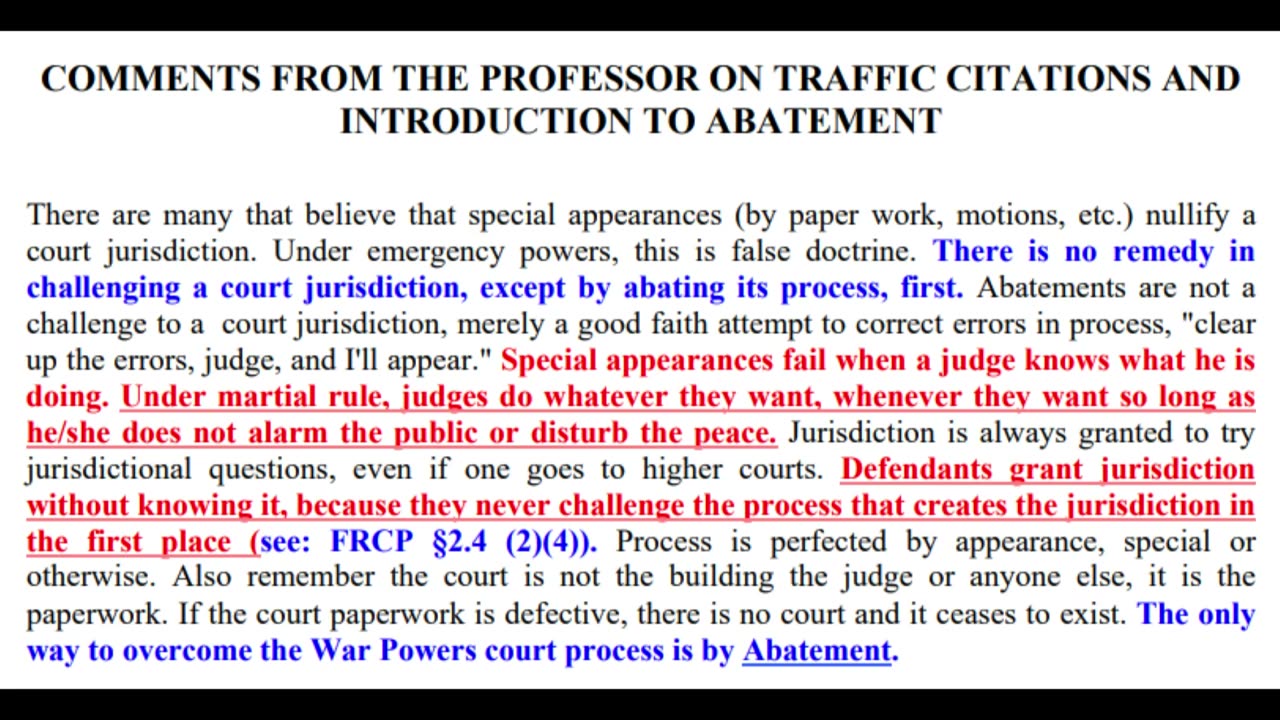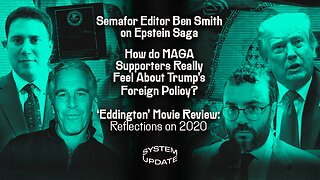Premium Only Content

Abatement in Pleading Common law Abatement Explained All You Need To Know
At common law an abatement in pleading or plea in abatement, was a defense to legal proceedings, which did not contest the principle of the plaintiff's right to relief, but contended that the plaintiff had made a procedural error, and needed to bring fresh proceedings, which followed the correct procedure. The objection could deal with (among others) place, time, or method of assertion. The plea in abatement was abolished as a particular form of response by the defendant when common-law pleading was replaced by Code Pleading and later by pleading rules, such as the federal Rules of Civil Procedure.
Successful assertion of pleas in abatement merely pause proceedings until the problem is remedied. There were two fundamental styles of abatement. The first was abatement in proceedings which would merely suspend the proceeding until the error was fixed. Abatement in law would terminate it completely, although it could be restarted at the plaintiff's request. The second term is more common. It has now been abolished in most if not all common law jurisdictions.
Quick guide on how to complete abatement at common law
Forget about scanning and printing out forms. Use our detailed instructions to fill out and eSign your documents online.
signNow's web-based DDD is specifically designed to simplify the organization of workflow and improve the entire process of qualified document management. Use this step-by-step guideline to complete the Law common abatement form swiftly and with idEval precision.
The way to complete the Common abatement law form on the internet:
To get started on the document, utilize the Fill camp; Sign Online button or tick the preview image of the document.
The advanced tools of the editor will direct you through the editable PDF template.
Enter your official identification and contact details.
Use a check mark to point the answer where required.
Double check all the fillable fields to ensure full precision.
Make use of the Sign Tool to add and create your electronic signature to sign Now the Law abatement common form.
Press Done after you finish the blank.
Now it is possible to print, save, or share the form.
Refer to the Support section or contact our Support crew in the event that you have any concerns.
Abatement of an Action
An entire overthrow or destruction of a suit so that it is quashed and ended.
The purpose of abatement is to save the time and expense of a trial when the plaintiff's suit cannot be maintained in the form originally presented. After an action abates, the plaintiff is ordinarily given an opportunity to correct errors in his or her PLEADING. If the plaintiff still is unable to allege the facts necessary to state a legal CAUSE OF ACTION, then the action is terminated.
Not every possible reason for dissatisfaction with another person can be heard by a court. When the old COMMON LAW form of action governed the procedure followed by courts (as opposed to state and federal rules of procedure, which now do), only legal wrongs that fit exactly into one of the allowed categories could be pleaded in court. If the defendant believed that the plaintiff's complaint did not fit one of these forms, the defendant could respond with a plea in abatement. A plea in abatement was called a dilatory plea because it delayed the time when the court would reach the merits of the plaintiff's claim, if ever.
The rigid formality of common law pleading became less satisfactory as legal disputes became more complicated. It has been replaced in each state by a procedure that allows the plaintiff to plead facts showing his or her right to legal relief. Modern systems of pleading retain a right for the defendant to seek abatement of the action when the plaintiff is not entitled to be in court. They allow a defendant to object to the court's jurisdiction, the venue of the trial, the sufficiency of process, or of the SERVICE OF PROCESS, the legal sufficiency of the plaintiff's claim, or the failure to include someone who must be a party. A plea in abatement is made either in the defendant's answer or by motion and order—that is, an application to the court for relief and an order that can grant it. Abatement is usually granted in the form of a dismissal of cause of action, and now the term dismissal is used more often than the term abatement for this procedure.
Today, the word abatement is most often used for the termination of a lawsuit because of the death of a party. Under the common law, a lawsuit abated automatically whenever a party died. This rule was considered a part of the substance of the law involved and was not merely a question of procedure. Whether the cause of action abated depended on whether or not the lawsuit was considered personal to the parties. For example, contract and property cases were thought to involve issues separate from the parties themselves. They were not personal and did not necessarily abate on the death of a party. Personal injury cases were considered personal, however, and did abate at death. These included claims not only for physical assault or negligent injuries inflicted on the body, but also for other injuries to the person—such as LIBEL, slander, and MALICIOUS PROSECUTION.
Today there are statutes that permit the revival of an action that was pending when a party died. An executor or administrator is substituted for the deceased party and the lawsuit continues. A lawsuit may not be revived unless the underlying cause of action, the ground for the suit, continues to have a legal existence after the party's death. Revival statutes vary from state to state, but today most lawsuits do not abate.
This general rule does not apply to matrimonial actions. A lawsuit for DIVORCE or separation is considered entirely personal and therefore cannot be maintained after the death of a party. Different states do make exceptions to this rule in order to settle certain questions of property ownership. An action for the ANNULMENT of a marriage after the death of an innocent spouse may be revived by the deceased spouse's PERSONAL REPRESENTATIVE if it is clear that the marriage was induced by FRAUD and the perpetrator of the fraud would inherit property to which he or she would otherwise not be entitled.
-
 1:01:18
1:01:18
What If Everything You Were Taught Was A Lie?
18 days agoIt's All Illegal Now In U.S.A. But In 40s 50s 60s It's Called Common Sense & Is Part Of Normal Life
2.2K4 -
 LIVE
LIVE
SpartakusLIVE
4 hours agoThe $1,000 Spartakus Gauntlet || Huskerrs and Twitty
413 watching -
 10:19
10:19
MattMorseTV
7 hours ago $0.58 earnedTrump just went SCORCHED EARTH.
6.25K14 -
 1:27:56
1:27:56
Glenn Greenwald
5 hours agoSemafor Editor Ben Smith on Epstein Saga; How do MAGA Supporters Really Feel About Trump's Foreign Policy? Eddington Movie Review: Reflections on 2020 | SYSTEM UPDATE #490
116K55 -
 LIVE
LIVE
megimu32
2 hours agoOTS: Infomercial Insanity | 80s-00s Gadgets That Sold Big (and Made Us Buy)
136 watching -
 LIVE
LIVE
Amish Zaku
3 hours agoA Celebration of Ozzy Osbourne's Life, Music, and Spirit
70 watching -
 48:41
48:41
The Mel K Show
4 hours agoMel K & Aaron Day | Wake up! Walking Blindly into Totalitarian Technocracy | 7-22-25
15.5K5 -
 1:05:20
1:05:20
BonginoReport
6 hours agoEpstein: From “Case Closed” to “To Be Continued” - Nightly Scroll w/ Hayley Caronia (Ep.95)
115K62 -
 LIVE
LIVE
Anthony Rogers
1 day agoEpisode 375 - Randy Valerio
34 watching -
 1:32:14
1:32:14
Kim Iversen
6 hours ago"Obama Belongs In Jail!" Tulsi Gabbard Exposes Entire Russiagate Hoax
101K105